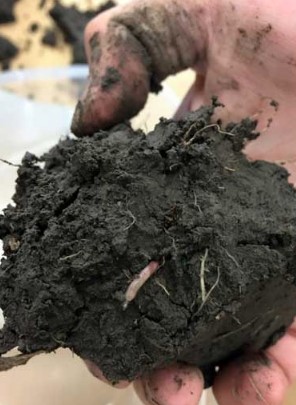By Laura Starr
Soil structure is a way to describe how mineral and organic particles are arranged in the soil. Structure is an important characteristic because it influences how stable and resilient the soil is to disturbance and erosion. It also plays an important role in water infiltration, aeration, root penetration, carbon storage, and nutrient cycling. Measuring soil aggregates is one way to determine the structural status of the soil. Aggregates are the small-scale clumps of bound soil particles and organic matter ranging from a half inch in diameter to microscopic in size. In general, the bigger and more numerous the aggregates, the better structure your soil has. Stable soil aggregates can hold soil particles together against wind, rain, and traffic more effectively than unbound free agents because they are literally stuck together.
Aggregates are often divided into two groups: macroaggregates (pea gravel size) and microaggregates (smaller than a grain of sand). Each group serves a different role in carbon cycling. Macroaggregates can be an important source of easily available carbon for soil microbial activity but breakdown relatively quickly in response to disturbance in the soil. Microaggregates act as more long-term carbon storage where they protect small amounts of organic matter from microbial breakdown. These aggregates are far more stable and resistant to destructive forces. Microaggregates can be formed inside of macroaggregates, which highlights the importance of macroaggregate formation. If macroaggregates are broken before microaggregates can be formed, the long-term storage of organic matter in soil can be compromised.
Aggregates are formed by attractive forces between particles, held together by sticky “organic glues” exuded by microorganisms, and physically molded together by plant roots and soil animals (Figure 1). Preventing aggregate breakdown and enhancing the activity of plants and microbes are the primary ways agricultural management can improve soil aggregation.

Figure 1. Earthworms exude sticky glues which help to build soil structure. Photo from K-State Research and Extension.
The following management practices have been shown to improve soil aggregation:
- Reduced tillage or no-till – Reduces disturbance and increases plant residue return to soil
- Crop rotation – Enhances plant-microbe-soil interactions
- Cover crops – Enhances plant-microbe-soil interactions, increases plant residue return to the soil
- Adjusting soil pH or cation availability with amendments such as lime or gypsum (in case of sodic soils) – Can increase soil particle binding from calcium input and/or improve soil pH to facilitate plant and microorganism growth
Source : ksu.edu